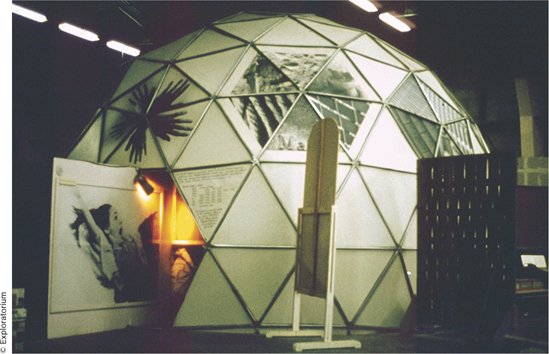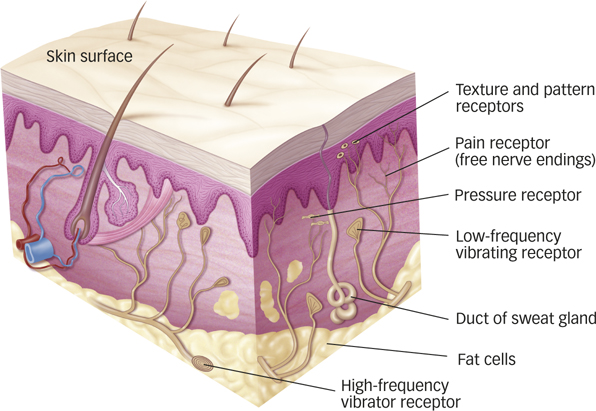4.5 The Body Senses: More Than Skin Deep
Vision and audition provide information about the world at a distance. By responding to light and sound energy in the environment, these “distance” senses allow us to identify and locate the objects and people around us. In comparison, the body senses, also called somatosenses (soma from the Greek for “body”), are up close and personal. Haptic perception is the active exploration of the environment by touching and grasping objects with our hands. We use sensory receptors in our muscles, tendons, and joints as well as a variety of receptors in our skin to get a feel for the world around us (see FIGURE 4.24).

haptic perception
The active exploration of the environment by touching and grasping objects with our hands.
Touch
Touch begins with the transduction of skin sensations into neural signals. Four types of receptors located under the skin’s surface enable us to sense pressure, texture, pattern, or vibration against the skin (see FIGURE 4.24). The receptive fields of these specialized cells work together to provide a rich tactile (from Latin, “to touch”) experience when you explore an object by feeling it or attempting to grasp it. In addition, thermoreceptors, nerve fibers that sense cold and warmth, respond when your skin temperature changes. All these sensations blend seamlessly together in perception, of course, but detailed physiological studies have successfully isolated the parts of the touch system (Hollins, 2010; Johnson, 2002).


There are three important principles regarding the neural representation of the body’s surface. First, the left half of the body is represented in the right half of the brain and vice versa. Second, just as more of the visual brain is devoted to foveal vision where acuity is greatest, more of the tactile brain is devoted to parts of the skin surface that have greater spatial resolution. Regions such as the fingertips and lips are very good at discriminating fine spatial detail, whereas areas such as the lower back are quite poor at that task. Think back to the homunculus you read about in the Neuroscience and Behavior chapter; you’ll recall that different locations on the body project sensory signals to different locations in the somatosensory cortex in the parietal lobe. Third, there is mounting evidence for a distinction between “what” and “where” pathways in touch analogous to similar distinctions we’ve already considered for vision and audition. The “what” system for touch provides information about the properties of surfaces and objects; the “where” system provides information about a location in external space that is being touched or a location on the body that is being stimulated (Lederman & Klatzky, 2009). The evidence from fMRI studies suggests that the “what” and “where” touch pathways involve areas in the lower and upper parts of the parietal lobe, respectively (Reed, Klatzky, & Halgren, 2005).
124
Why might discriminating spatial detail be important for fingertips and lips?
Touch information can have a powerful effect on our decisions and judgments. For example, recent research has shown that merely touching an object that we don’t already own can increase our feeling of ownership and lead us to value the object more highly than when we view it but don’t touch it (Peck & Shu, 2009); the longer we touch an object, the more highly we value it (Wolf, Arkes, & Muhanna, 2008). You might keep this “mere touch” effect in mind the next time you are in a shop and considering buying an expensive item. Retailers are probably aware of this effect: During a recent holiday shopping season, the office of the Illinois state attorney general warned shoppers to be cautious in stores that encouraged them to touch the merchandise (Peck & Shu, 2009).
Pain
Although pain is arguably the least pleasant of sensations, it is among the most important for survival: Pain indicates damage or potential damage to the body. Without the ability to feel pain, we might ignore infections, broken bones, or serious burns. Children with congenital insensitivity to pain, a rare inherited disorder that specifically impairs pain perception, often mutilate themselves (e.g., by biting into their tongues or by gouging their skin while scratching) and are at increased risk of dying during childhood (Nagasako, Oaklander, & Dworkin, 2003).
125
Tissue damage is transduced by pain receptors, the free nerve endings shown in FIGURE 4.24. Fast-
Neural signals for pain travel to two distinct areas in the brain and evoke two distinct psychological experiences (Treede et al., 1999). One pain pathway sends signals to the somatosensory cortex, identifying where the pain is occurring and what sort of pain it is (sharp, burning, dull). The second pain pathway sends signals to the motivational and emotional centers of the brain, such as the hypothalamus and amygdala, and to the frontal lobe. This is the aspect of pain that is unpleasant and motivates us to escape from or relieve the pain.
Pain typically feels as if it comes from the site of the tissue damage that caused it. If you burn your finger, you will perceive the pain as originating there. But we have pain receptors in many areas besides the skin: around bones and within muscles and internal organs as well. When pain originates internally—
referred pain
Feeling of pain when sensory information from internal and external areas converges on the same nerve cells in the spinal cord.
One influential account of pain perception is known as the gate-control theory of pain, which holds that signals arriving from pain receptors in the body can be stopped, or gated, by interneurons in the spinal cord via feedback from two directions (Melzack & Wall, 1965). Pain can be gated by the skin receptors, for example, when you rub the affected area. Rubbing your stubbed toe activates neurons that “close the gate” to stop pain signals from traveling to the brain. Pain can also be gated from the brain by modulating the activity of pain-
gate-control theory of pain
A theory of pain perception based on the idea that signals arriving from pain receptors in the body can be stopped, or gated, by interneurons in the spinal cord via feedback from two directions.
Why does rubbing an injured area sometimes help alleviate pain?
Although some details of the gate-
Body Position, Movement, and Balance

It may sound odd, but one aspect of sensation and perception is knowing where parts of your body are at any given moment. Your body needs some way to sense its position in physical space other than relying on the movement of your eyes constantly to visually check the location of your limbs. Sensations related to position, movement, and balance depend on stimulation produced within our bodies. Receptors in the muscles, tendons, and joints signal the position of the body in space, whereas information about balance and head movement originates in the inner ear.
126
Sensory receptors provide the information we need to perceive the position and movement of our limbs, head, and body. These receptors also provide feedback about whether we are performing a desired movement correctly and how resistance from held objects may be influencing the movement. For example, when you swing a baseball bat, the weight of the bat affects how your muscles move your arm as well as the change in sensation when the bat hits the ball.
Maintaining balance depends primarily on the vestibular system, the three fluid-
vestibular system
The three fluid-
Why is it so hard to stand on one foot with your eyes closed?
Vision also helps us keep our balance. If you see that you are swaying relative to a vertical orientation, such as the contours of a room, you move your legs and feet to keep from falling over. Psychologists have experimented with this visual aspect of balance by placing people in rooms that can be tilted forward and backward (Bertenthal, Rose, & Bai, 1997; Lee & Aronson, 1974). If the room tilts enough—
SUMMARY QUIZ [4.5]
Question 4.13
| 1. | Which part of the body occupies the greatest area in the somatosensory cortex? |
- calves.
- lips.
- lower back.
- hips.
b.
Question 4.14
| 2. | The location and type of pain we experience is indicated by signals sent to |
- the amygdala.
- the spinal cord.
- pain receptors.
- the somatosensory cortex.
d.
127